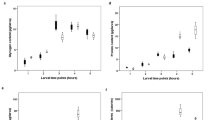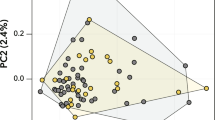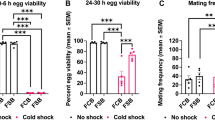Summary
Experimental populations of Drosophila willistoni adapted to low, median and high pH substrate (pH 2, pH 5 and pH 10) were tested by the multiple choice technique, and a significant sexual preference was observed for homogamic insemination, which was greater among populations derived from the centre of the species distribution than the ones collected near the margin of its distribution range. It was also observed that some of the F1 and F2 hybrids, between flies adapted to different foods, were reproductively inferior on the parental substrate.
The greater divergence of the central populations may be due to their significantly greater chromosomal and genie polymorphism than the margins, populations.
Similar content being viewed by others
Article PDF
References
Ayala, F J. 1973. Two new subspecies of the Drosophila willistoni groups (Diptera: Drosophilidae). Pan Pacific Entomologist, 49, 273–279.
Ayala, F J, and Powell, J B. 1972. Allozymes as diagnostic characters of sibling species of Drosophila. Proc Natl Acad Sci, 69, 1094–1096.
Ayala, F J, and Tracey, M L. 1973. Enzyme variability in the D. willistoni group. VIII. Genetic differentiation and reproductive isolation between two subspecies. J Hered, 64, 120–124.
Chabora, A J. 1968. Disruptive selection for sternopleural chaeta number in various strains of D. melanogaster. Amer Natur, 102, 525–532.
Cordeiro, A R, Towsend, J I, Petersen, J A, and Jaeger, E C. 1958. Genetics of southern marginal populations of Drosophila willistoni. Proc X Inter Congr Genet Montreal, 3, 58–59.
Da Cunha, A B, and Dobzhansky, Th. 1954. A further study of chromosomal polymorphism in D. willistoni in its relation to the environment. Evolution, 8, 119–134.
De Souza, H L, De Toledo, J S, and Pavan, C. 1961. Incompatibilidade cromossômica e esterilidade masculina em D. willistoni. Atas do I Simpósio Sul-Americana de Genética, 303–305 (São Paulo).
De Toledo, C J. 1971. Estudo da esterilidade entre diferentes linhagens de D. willistoni. Rev Brasil Biol, 31, 145–151.
Del Solar, E. 1966. Sexual isolation caused by selection for positive and negative phototaxis and geotaxis in Drosophila pseudoobscura. Proc Nat Acad Sci, (US), 56, 484–487.
Dobzhansky, Th. 1975. Analysis of incipient reproductive isolation within a species of Drosophila. Proc Nat Acad Sci, (US), 72 (9), 3638–3641.
Dobzhansky, Th, and Mayr, E. 1944. Experiment on sexual isolation in Drosophila. I. Geographic strains of D. willistoni. Proc Nat Acad Sci, 30, 238–244.
Ehrman, L. 1964. Genetic divergence in M. Vetukhiv's experimental populations of D. pseudoobscura. Genet Res, 5, 150–157.
Gibson, J S, and Thoday, J M. 1963. Effects of disruptive selection. VIII. Imposed quasi-random mating. Heredity, 18, 513–524.
Knight, G R, Robertson, A, and Waddington, C H. 1956. Selection for sexual isolation within a species. Evolution, 10, 14–22.
Koref-Santibañez, S, and Waddington, C H. 1958. The origin of isolation between different lines within a species. Evolution, 12, 485–493.
Levene, H. 1949. A new measure of sexual isolation. Evolution, 3, 315–321.
Littlejohn, M J. 1969. The systematic significance of isolating mechanisms. In Systematic Biology, pp. 459–482. Nat. Acad. Sci. (US), Publ. no. 1692, Washington.
Mather, K, and Harrison, B J. 1949. The manifold effect of selection. Heredity, 3, 1–52, 131–162.
Oliveira, A K, and Cordeiro, A R. 1980. Adaptation of Drosophila willistoni experimental populations to extreme pH medium. I. Changes in viability and developmental rate. Heredity, 44, 111–122.
Patterniani, E. 1969. Selection for reproductive isolation between two populations of maize, Zea mays L. Evolution, 23, 534–547.
Pavan, C, Cordeiro, A R, Dobzhansky, N, Dobzhansky, Th, Malogolovkin, C, Spassky, S, and Wedel, N. 1951. Concealed genie variability in Brazilian population of D. willistoni. Genetics, 36, 13–30.
Reguly, M L, and Cordeiro, A R. 1980. Adaptation of D. willistoni experimental populations to extreme pH. medium. III. Esterase polymorphism (in prep.).
Shorloo, W. 1967. Disruptive selection on sternopleural chaeta number. Genet Res, 9, 115–118.
Thoday, J M, and Gibson, J B. 1962. Isolation by disruptive selection. Nature, 193, 1164–1166.
Thoday, J M, and Gibson, J B. 1970. The probability of isolation by disruptive selection. Amer Natur, 104, 219–230.
Winge, H. 1971. Niveis de divergência evolutiva no grupo criptico da D. willistoni. Tese de doutoramente apresentada ao curso de pós-graduação da UFRGS.
Author information
Authors and Affiliations
Rights and permissions
About this article
Cite this article
de Oliveira, A., Cordeiro, A. Adaptation of Drosophila willistoni experimental populations to extreme pH medium. Heredity 44, 123–130 (1980). https://doi.org/10.1038/hdy.1980.11
Received:
Issue Date:
DOI: https://doi.org/10.1038/hdy.1980.11
This article is cited by
-
Incipient speciation by divergent adaptation and antagonistic epistasis in yeast
Nature (2007)
-
Assortative Mating in Drosophila Adapted to a Microsite Ecological Gradient
Behavior Genetics (2005)
-
Heterosis in crosses between lines of Drosophila melanogaster selected for adaptation to different environments
Theoretical and Applied Genetics (1989)



